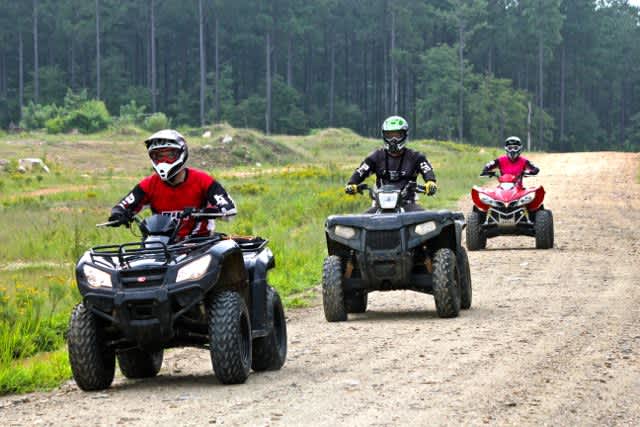Do You Make These ATV Riding Mistakes?
Mitch Strobl 08.31.12

Staring at my buddies on top of the ridge, I was about to try something I had never done before. See, every so-called rider at my high school was expected to scale the infamous Devil’s Backbone. A teenager at the time, I was determined to make it up like the rest of my friends. I hit the throttle and started up the monstrous hill. A quarter of the way up, things were going fine, my confidence was climbing as fast as my ATV climbed the hill. Halfway up, my rear tires caught a root, flipping my ATV and sending me rolling down the hill. I stopped myself from tumbling, only to be smashed by my ATV. The underbody did a job on my helmet, which protected my head. I was lucky the accident wasn’t more serious.
“ATVs are fun machines, but they need to be treated with respect,” said Van May, ATV expert and Yamaha product trainer. “It’s easy to get hurt on an ATV, and as a product trainer, I can’t stress enough the importance of practicing safety on these machines.”
According to the U.S. Consumer Product Safety Commission, there were 172 ATV related deaths in the U.S. in the first six months of 2012, with peak accident months still to come. In recent years, the average number of total accidents has exceeded 130,000. While the numbers may seem daunting, riders who pay special attention to ATV safety tactics can avoid becoming a statistic.
With Labor Day right around the co rner, many riders are gearing up for a weekend of fun so now is the time to learn how to stay safe.
rner, many riders are gearing up for a weekend of fun so now is the time to learn how to stay safe.
“We’re projecting about double the traffic we normally have this time of year,” said Al Mitchell, manager of operations at Carolina Adventure World.
Maybe you are planning on riding this weekend. If so, what kind of things can you be on the lookout for this Labor Day?
“The most obvious thing is to wear a DOT and SNELL-approved helmet. It’s the most crucial piece of your riding outfit,” said May.
Before you even consider riding, you must have the appropriate gear. You want to have the correct clothes but look cool at the same time, right? Luckily, most of today’s gear is extra sporty but more importantly, it’s designed to keep you safe.
- Helmet: A helmet is the single most important piece of protection an ATV rider can wear. Never ride an ATV without a helmet. Make sure you get a full-faced, DOT and Snell Foundation approved helmet because it will offer the most protection to your head and face.
- Eye Protection: You must be able to see clearly to ride safely. A pair of goggles will protect your eyes from dust and debris on the trail.
- Gloves: A pair of good gloves will improve your grip on the handlebars, plus protect your hands from scratches.
- Boots: Off-road style ATV boots offer the best protection for your feet, ankles and legs. At least have a sturdy pair of over-the-ankle boots to protect your feet while riding.
- Protective Outer Clothing: Long pants and a long-sleeved shirt are minimal requirements for rider protection. Most riding jerseys and pants are sporty looking while offering better protection.
The holiday weekend introduces another risk factor for riding ATVs.
“Holidays tend to turn into a party. We must remind people that alcohol and riding do NOT mix,” May said. “A combination of the two could be fatal.”
While these reminders hardly scratch the surface of ATV safety as a whole, the main point is to hit the trails with a safety-conscious mind, ride smart, and get home safe. Know your machine’s limitations and, more important, your limitations as a rider. Finally, if there’s a hint of doubt in your mind, don’t let peer pressure override your gut feeling like I did as a teenager. It’s simply not worth it.
You can learn more about rider safety by taking an online off-road safety course at www.offroad-ed.com. The training offered at this site is approved by the state agencies responsible for ATV safety education, and it’s the same material that’s taught in the classroom.
Studying at offroad-ed.com is free. Those who must be certified to obtain an off-road safety certificate pay a one-time fee, which is due only if they pass the course. Online off-road safety courses are available in participating states, so visit www.offroad-ed.com to take a course specific to your state.

